The relations of the Russian Orthodox Church Outside of Russia (ROCOR) with the Axis powers and their allies between 1939–1945 were of a difficult, ambiguous nature and changed drastically on several occasions. The Church’s relations with Nazi Germany are of particular importance. During the 1930s, Russian émigrés constituted a majority of Orthodox Christians in Germany, and Greeks, Bulgarians, Serbs, and Romanians were often members of Russian parishes. It is thus no coincidence that the Reichskirchenministerium’s (RKM) protective policy vis-à-vis the ROCOR had to do with gaining influence over the Balkan Orthodox Churches. For instance, on July 9, 1938, Reichsminister Hanns Kerrl wrote to the Finance Ministry with a petition to have an Orthodox cathedral built in Berlin: “Among other things, support from the Russian Orthodox Church will have a beneficial impact on the German Reich’s relations with the states to the South-east (Bulgaria, Romania, Yugoslavia), where the Church plays a huge role in political life. Perhaps, as a result of our supporting the Russian Orthodox Church in Germany, these states will join the anti-Bolshevist front spearheaded by the Third Reich.”[1]Bundesarchiv Berlin (BA), R2/5023, Bl. 23–24.
However, the more influential Nazi foreign-policy establishment deemed Russian Orthodoxy to be under the influence of Western countries hostile to Germany and the ROCOR to be an active vector for foreign Russian nationalist and monarchist ideology, and furthermore associated with Patriarch Gavrilo of Serbia, an enemy of the Third Reich. In a note on the Patriarch’s arrest from June 11, 1941 by the Foreign Policy Service of the National Socialist German Workers’ Party (NSDAP), we read: “In Sremsky Karlovtsy, there is a Synod of Russian refugee bishops. This Synod is a mouthpiece for reactionary movements in the Russian Orthodox Church… In 1938, a congress of representatives of all the Greek Orthodox [sic!] Churches of all countries took place in Sremtsy Karlovtsy. At this congress, a manifesto was put forward declaring Grand Duke Vladimir to be the Tsar of Russia.”[2]Ebd., NS43/35, Bl. 62. There is notable exaggeration in this memorandum: the Russian All-Diaspora Church Council of 1938 was attended only by representatives of the Russian diaspora church, and even then not the entirety of it.
Some of the reasons for the (Reich Ministry for the Occupied Eastern Territories, RMO) RMO’s negative attitude toward the ROCOR were set out in a report by its main policy department from July 17, 1942, concerning the undesirable activities of Russian monarchists: “The work of the legitimists extends to the Russian Orthodox Church, too, which is especially receptive to us… The Russian Synodal Church [i.e. the ROCOR —trans.] came into the field of view of the global community during the present war thanks to support from such a figure as Patriarch Gavrilo of Serbia, who kept up close relations with Russian legitimists in Yugoslavia and was arrested as a Serbian persecutor [sic!, viz. of Germany —trans.] after the entry of German troops into Yugoslavia”.[3]Institut für Zeitgeschichte München (IfZ), MA246, Bl. 676-677.
Had the Third Reich won the Second World War, it is likely that the ROCOR would have met a tragic fate. In a report by the Sicherheitsdienst from February 2, 1942, it is stated that after the downfall of Bolshevism, the “Karlovtsy matter” would have to be resolved somehow, since a renewal of theocratic tendencies such as during Czarist times could not be permitted to happen.[4] BA, R58/220, Bl. 279.
The military conflict that flared up in Europe in September 1939 did not immediately have an effect on the activities of the Synod of Bishops. Yugoslavia, where the ROCOR governing body was situated, remained a neutral state for over a year after that; however, difficulties gradually arose in relation to dioceses within the territory of the combatant countries. Metropolitan Anastasy was concerned about more serious complications in the near future and wrote a letter to Protopresbyter Sergii Orlov in Geneva asking him whether the center of church operations could be transferred to Switzerland in order for it to be outside the conflict zone. This letter was seized by the Gestapo, which perceived it with a great deal of suspicion.[5]Bishop Gregory Grabbe. Zavet sviatogo patriarkha [Legacy of the Holy Patriarch]. Moscow, 1996. pp. 55, 323. The German occupation of an array of European countries made communication between the local ROCOR communities and the Synod of Bishops very difficult.[6] Russian State Archive (GARF), Fonds 6343, Series 1, File 283, Item 19.
The ROCOR leadership and that of the Russian diaspora reacted positively to the anti-German coup in Yugoslavia on March 27, 1941. Metropolitan Anastasy immediately sent a congratulatory telegram to the new Yugoslav King Peter II. This communiqué did not give a political assessment of the coup, but the German occupying powers later interpreted it in a light that was unfavorable for the Metropolitan.[7]V. Maevskii. Russkie v Iugoslavii 1920-1945 [Russians in Yugoslavia, 1920–1945]. Vol. 2. New York, 1966. pp. 257–258.
On April 12, 1941, Wehrmacht divisions entered the destroyed capital of Yugoslavia. Oppression of the leadership of the Serbian Orthodox Church followed shortly thereafter. Patriarch Gavrilo was arrested and placed under guard in a monastery. The Russian diaspora likewise faced all manner of constraints and restrictions by the occupying powers.[8]Grabbe, op. cit., pp. 324–325, 330–331; Arkhipastyrskie poslaniia, slova i rechi Vysokopreosviashchenneishego Mitropolita Anastasiia, Pervoierarkha Russkoi Zarubezhnoi Tserkvi [Archpastoral … Continue reading Under these conditions, the ROCOR leadership adopted a wait-and-see attitude.[9] Maevskii, op. cit., p. 271.
As it happens, Metropolitan Anastasy still tried to establish contact with the occupying administration. On April 30, he reported to a meeting of the Synod of Bishops that he had visited General Förster, commander of the German forces in Serbia, and the latter had stated that the Synod could continue its activities without hindrance and that he would report on the Metropolitan’s visit to the Reichskirchenministerium.[10]Synodal Archive (SA) of the Russian Orthodox Church Outside of Russia, New York. Minutes of the Synod of Bishops, 28.11.1940–18.09.1946.
Shortly after the beginning of the occupation, nearly all Russian periodicals were shut down and the activities of public Russian émigré organizations known not to be reliably loyal were stopped. On June 22, 1941, the day Germany invaded the USSR, Vladyka Anastasy’s premises were raided. To the Gestapo, Vladyka Anastasy had the reputation of being an Anglophile, due to, among other things, his close links with the English administration of Palestine when he was the bishop of the Russian Orthodox Mission in Jerusalem. The Gestapo agents were thus searching for correspondence that might compromise him.[11]Maevskii, op. cit., p. 258. From German archival documents, it is evident that Gestapo chief Heinrich Müller had sent Neuhaus, a major official from the RSHA, to raid the archives of the Serbian Orthodox Church and the ROCOR, but with respect to the latter, the planned operation had to be postponed by a month and a half.
At the same time as the raid on Metropolitan Anastasy, a thorough search was conducted in the chancellery of the Synod of Bishops and in the flat of Synodal administrator G. P. Grabbe, who was placed under house arrest for several days. In a letter to Archbishop Antonii (Bartoshevich), dated January 6, 1987, G. P. Grabbe’s son Konstantin stated (somewhat exaggerating the scale of the oppressive measures): “Metropolitan Anastasy was arrested by Hitler, and our whole family was also put under house arrest for a whole week, and all of our visitors were registered and records kept of them.”[12] Stanford University Special Collections Librarian, Grabbe (Grigorii) Papers, Box 1, Folder 7.
The records seized during the raid on the Synod and other documents were sent off to Germany to be studied. The Gestapo was unable to find information about the Metropolitan’s political activities and it left him alone. His case was closed in part due to the influence of General Schröder, commander of the German troops in Yugoslavia.[13]GARF, Fonds 6343, Series 1; Zalizetskii, I. “Sotrudniki vymyshlennye i iavnye” [“Imagined and Open Collaborators”], in: Pravoslavnaia Rusʹ [Orthodox Russia] 10–11/1993, p. 11; Grabbe, op. … Continue reading The military administration in Yugoslavia as well as in the occupied territories of the USSR was trying to enact a gentler policy with respect to the Russian Church than the other agencies were.
It is doubtless that a significant number of right-leaning émigrés thought the Third Reich was a lesser evil than the Stalinist regime. They welcomed the start of the war between Germany and the USSR in the hope that the latter regime would soon fall and the Russian people would be freed from the communist dictatorship. In 1941, the whole Russian diaspora, including those in Yugoslavia, split into two groups of “defenders” and “defeatists”. The former thought that Nazi Germany was trying to destroy Russia as a state, while the latter thought they were only trying to destroy Bolshevism within Russia. On the basis of their respective views, some asserted that the USSR ought to be helped in the war, while others desired for it to be defeated. However, even those who were on the German side did not want Russia to be defeated; they simply saw Germany as a lesser evil than the Soviet regime, and wanted to turn the war that had flared up into a struggle to liberate their country with assistance from the Russian population.[14]Archive of ROCOR Holy Trinity Seminary, V. A. Maevskii Collection, Athos; V. A. Maevskii. “Tragediia russkikh v Iugoslavii” [“The Tragedy of the Russians in Yugoslavia”], in: Russkaia … Continue reading
In this connection, one must distinguish between the stance of the governing bodies of the ROCOR and the opinion of various secular émigré organizations and individual clergymen. In the early days of World War II, certain ROCOR bishops and priests wrote articles and proclamations welcoming the Wehrmacht’s campaign in the USSR. The best known of these is the encyclical of Seraphim Lukianov, Metropolitan of Western Europe, dated June 22, 1941.[15] Seide G. Verantwortung in der Diaspora, die Russische Оrthodoxe Kirche im Ausland. München, 1989. S. 114; BA, R5101/22184, Bl. 30.
However, there were also ROCOR clergymen who were very much against the Nazis and against Germany, for example, Archimandrite (future Archbishop) Nathaniel Lvov. According to (far from complete) figures compiled by scholars at Saint Tikhon’s University, “21 members of the Russian diaspora clergy suffered at the hands of the Nazis, including for saving Jews”.[16]Emelʹianov N. “Predstaviteli russkogo zarubezh’ia, za Khrista postradavshie” [“Members of the Russian Diaspora Who Suffered for Christ’s Sake”], in: XVIII ezhegodnaia bogoslovskaia … Continue reading Among them were Protopresbyter Andrei Vrasskii (in France) and Archmandrite Grigol Peradze (in Poland), who were arrested and died in concentration camps for their involvement in the Resistance and for helping Jews. It is also worth mentioning that a ROCOR parishioner of Russo-German origin, Alexander Schmorell, was executed by the Nazis for his involvement in the underground Weiße Rose resistance group in Munich and canonized by the ROCOR in 2012.
As early as June 26, 1941 four days after the raid on his premises, Metropolitan Anastasy, still nurturing unfounded illusions, sent a letter to the Reichskirchenministerium through the intermediary of General Schröder asking him to make a petition on his behalf in order to gain permission for him to travel to Berlin. What Vladyka wanted to discuss with the German authorities was, above all else, the matter of satisfying the spiritual needs of the people on the occupied territories of Russia and of organizing a church administration there.[17]Russian State Military Archive (RGVA), Fonds 1470, Series 1, File 1, Item 83.
The Reichskirchenministerium, which had traditionally maintained a positive stance toward the ROCOR and, moreover, saw the letter as an impetus to set about dealing with church affairs in the East, immediately consented. On July 12, Archbishop Seraphim Lade of Berlin and Germany wrote to the Metropolitan: “The Reichsministerium […] has informed the ministry of foreign affairs and the state police that it has no objections to your traveling to Germany.”[18]SA, File 15/41, Items 2, 5. However, other, considerably more influential agencies, in particular the Ministry for the Occupied Eastern Territories, the RSHA, and the Ministry of Foreign Affairs took the opposing view. The very fact that the Metropolitan might conduct talks with the RKA was categorically unacceptable to them. Thus, in late July, Vladyka Anastasy was for the first time refused permission to travel to Berlin. Among others, secret police chief van der Leben wrote to the RKM on July 29 that he was against Metropolitan Anastasy and G. P. Grabbe traveling to Germany.[19]RGVA, Fonds 1470, Series 1, File 1, Item 79.Essentially, what we see here is a policy whereby the Synod of Bishops was deliberately isolated and even impeded from contacting Archbishop Seraphim of Berlin. Almost all postal communications between the Synod and the outside world were cut off. What is more, this policy of isolation began to be enacted even before Germany invaded the USSR.[20]Ibid., Item 74.
This first refusal was followed by multiple further failed attempts by the First Hierarch. On July 29, Vladyka Anastasy met with General Schröder and Felix Benzler, the authorized representative of the Ministry of Foreign Affairs in Belgrade. The latter was not yet aware of the views of his superiors and promised to help the Metropolitan to obtain the permission he was seeking. That same day, Benzler sent a telegram to his agency’s leadership recommending that they accommodate the Metropolitan’s request. Not long before that, the Ministry of Foreign Affairs had received a letter from the RKM dated July 11 and the negative response by Alfred Rosenberg “for reasons of principle”. The Ministry of Foreign Affairs took the same view. In a memo dated August 12, Granow, head of the Department of Culture, stated his objections to the RKM’s proposal and asserted that “regulating the relations with the Orthodox Churches outside the Reich is not the preserve or prerogative of the Kirchenministerium, but rather falls within the remit of the Ministry of Foreign Affairs”.[21]BA, R901/69680, Bl. 85, 88, R901/69300, Bl. 128.
The Synod of Bishops also expressed views on creating a church governing body in the occupied areas of Russia. On October 1, Metropolitan Anastasy sent Archbishop Seraphim Lade a brief verdict of the Synod about the regulation of church affairs in Russia. It speaks of a twofold task: 1. restoring church life in the provinces freed from Communist rule; and 2. reforming a legitimate church authority for all of Russia. To tackle the first task, it was suggested that Synod be given the power to second bishops to Russia. It was admitted that the second problem was “hardly fully solvable until all of Russia is freed from Communist rule and the fate of Metropolitan Cyril of Kazan, the head of the Moscow Patriarchate, has been cleared up”. Until such a time, it was considered necessary to “convene a Council in Moscow in the near future consisting of all the existing bishops of the Russian Church who had not been compromised by collaboration with Metropolitan Sergius and by taking part in his Synod, and headed by the most senior of them, and to constitute a temporary supreme church governing body that would then convene an All-Russian Council to restore the institution of the Patriarchate and decide on the future structure of the Russian Church.”[22]Ibid., Item 7, 10-12.
On October 29, Metropolitan Anastasy, who had not lost hope of obtaining permission to travel to Berlin, submitted a memorandum from the Synod to the authorized representative of the German foreign ministry in Belgrade with some suggestions for how to regulate church life in Russia. This document was to a large extent a reiteration of the October 1 letter.[23]Ibid., Item 32.
After the German attack in the spring of 1942, in the expectation that Moscow would be captured by the summer, the Synod decided to make preparations for this scenario and made one last appeal to the German authorities with suggestions for how to organize church governance in Russia.[24]Ibid., Item 27-30. The historian Georg Seide wrote completely correctly: “From this document, one can clearly see that the Russian bishops in the diaspora showed a great interest in restoring a canonical church authority in Russia, yet it could only be restored by a council of all bishops… The German government, for its part, made every effort to prevent the bishops of the Russian Church Abroad from exerting any influence on church life in the occupied territories, since what the German government envisioned was not a strong, unified Russian church, but the fragmentation of the same. Berlin was obviously scared that the Orthodox Church could be a force for national cohesion.”[25]Seide G., a.a.O., S. 117, 119. At the same time, it ought to be noted that, in this early period, both Metropolitan Anastasy and the Synod of Bishops were very wrong in their assessments of the Germans’ plans and the Third Reich’s church policies. The ROCOR hierarchs also knew very little about the internecine struggle among the German agencies and the Reichskirchenministerium’s near-complete loss of influence. Appealing to Berlin did not make any sense at all. All the letters from the Synod about plans to create a church authority in Russia remained unanswered.
Despite various bans, the ROCOR sought to play its part in reviving church life in the USSR in any way possible. This was primarily manifested in assistance by providing ecclesiastical literature and liturgical objects.[26]SA, File 17/41. On November 11, 1941, the ROCOR First Hierarch petitioned General Turner, commander of the German armed forces in Serbia, for official permission to provide charitable assistance in Russia. In it, he referred to a notice in the Russian newspaper Novoe Slovo, yet did not know that such fundraising activities were forbidden in Berlin.[27]Ibid., File 15/41, Item 14. He ultimately did not obtain permission in Belgrade.
In September 1941, Metropolitan Anastasy gave his blessing to form a Russian guard corps in Yugoslavia, which many members of his flock joined. Vladyka Anastasy took part in parades with the corps, celebrated services of intercession for them, and accepted tokens of gratitude from he commanders “for their constant attention to the spiritual needs of the group, etc.”[28] Tserkovnaia Zhiznʹ 10/1942, pp. 154–155, 1943, 5/1942, pp. 73–74; Russkii korpus [The Russian Corps]. New York, 1963, pp. 39–40, 115. The Metropolitan remained true to his policy of supporting anti-communist Russian divisions right through to the end of the War, as manifested in his contacts with Vlasov’s Russian Liberation Army from 1944–1945.
Metropolitan Anastasy kept a close eye on the situation in the church in the East and in his letters constantly asked Vladyka Seraphim to keep him as well informed about it as possible. The Metropolitan was very happy to receive messages about a lively religious revival in the territories occupied by the Wehrmacht and this partially explains some of the pro-German notes struck by his letters in the initial stages of the war.[29]Tserkovnaia Zhiznʹ 4/1942. pp. 49–51. However, Vladyka soon began to receive information about the cruelty of the Nazi occupation and his appeals to believers began to feature calls to end the terrible conflagration of the war and admissions that some of his prior hopes had been false.[30]Ibid., 12/1942, pp. 177–180; Parizhskii nabliudatelʹ [The Paris Observer], January 16, 1943.
In 1943, evidently trying to break out of its isolation and feeling alarmed about its future, the Synod of Bishops took the liberty to do what it had not done previously (or afterward) and sent several letters of congratulations to representatives of the occupying authorities, to which it received grateful replies. For instance, on February 16, 1943, the Synod heard letters of thanks for the Synod’s Christmas greetings from the adjutant to the commander-in-chief of the German Forces in Serbia, the Feldkommandant, and the German consul in Belgrade, and on May 17 of the same year, it heard letters from General Bader, Commander-in-Chief of the German forces in Serbia, and foreign affairs officer Benzler “thanking them for their greetings on the occasion of the birthday of Adolf Hitler, the Führer of the German people”.[31]SA, Minutes of the Synod of Bishops, 15/28.11.1940–28.10/10.11.1950.
However, the Foreign Ministry replied to this letter on August 11 by categorically refusing – as before – to allow Metropolitan Anastasy into Germany. There followed two persuasive letters from the chief of police and the SD, on September 8 and 17, 1943. However, it is likely that the Foreign Ministry would not have changed its stance had certain events not occurred in the USSR that startled the Nazi leadership: Stalin’s meeting with the leaders of the Moscow Patriarchate on September 4 and the election of Sergius Stargorodskii as Patriarch on September 8. Impressed by these events, the aide Kolrep sent a telegram to Benzler in Belgrade on September 23 saying that the planned negotiations between Metropolitans Anastasy and Seraphim in Belgrade “have a definite political significance in light of the election of [Metropolitan] Sergius” and Kolrep himself intended to consent to the Metropolitan Anastasy’s trip, “all the more so because this will give us a unique opportunity to acquire influence over the Belgrade Synod”.[32]Ebd.
On September 14, Metropolitan Anastasy declared that he did not recognize the election of the Patriarch of Moscow, going on the views expressed by the Council of Russian Bishops Abroad long before the war, on his own initiative and without any German pressure.[33]Metropolitan Anastasy. “Po povodu izbraniia na Patriarshii Prestol b. Mestobliustitelia Patriarshego Prestola Mitropolita Sergiia” [“On the Election of Metropolitan Sergii, Locum Tenens of the … Continue reading Not everything in Metropolitan Anastasy’s declaration suited the German authorities – among other things, that he quoted Stalin’s appeal to the Russian people – but on the whole it was perceived by the German Foreign Ministry as an unanticipated win.[34]АА, Inland I-D, 4797. Accordingly, what was allowed to take place in Vienna was not simply a meeting of the two Metropolitans, but rather a whole conference of Bishops (the only one during the war). The Conference, which was officially titled “The Archpastoral Conference of Hierarchs of the Russian Orthodox Church Outside of Russia”, was held in Vienna from October 21–26, 1943, in the premises of the Church of the Holy Protection. It was attended by 14 people.[35]SA, File 38/43.
A telegram by Kolrep from Vienna to the Foreign Ministry dated October 21, 1943, states that the draft resolution on the election of the Patriarch had been discussed by representatives of the secret police, the Reich Ministry for the Occupied Eastern Territories, and the Foreign Ministry, which had made a series of changes to it. Bishops collaborating with the German authorities were supposed to present these changes during the consultations as if they were their own suggestions and ensure that they were adopted. There were serious concerns that Metropolitan Anastasy, who had no idea about the German plot, would not sign the planned documents. In a telegram, Kolrep noted that this would render the whole operation pointless, and emphasized that: “Until now, Anastasy has been deliberately kept in the dark about the political significance that the German side attaches to his resolution.”[36]АА, Inland I-D, 4797. It proved impossible to find the text of the changes proposed by the Germans in the archives, making it hard to say to what extent they were incorporated into the final resolution. On the whole, though, it can be stated that the conference was not entirely under German control.[37]SA, File: 1943 Vienna Conference.
The Vienna Conference was thus a noteworthy event for the Russian Church Abroad, yet it hardly concluded the first phase of its history, as Georg Seide has opined.[38]G. Seide, a.a.O., S. 122. From late 1943–early 1945, it remained in keeping with the trajectory of previous years. The stance of the German authorities did not really change, either, and after the Conference, they continued with their policy of isolating the Synod of Bishops.
Changes in the course of the war had a direct effect on the fate of the ROCOR Synod of Bishops. Around this time, the bishops began to strike new notes in their encyclicals, while maintaining their anti-communist bent. For instance, Metropolitan Anastasy’s 1944 Christmas encyclical, apart from an entreaty to God to halt the current bitter strife by “making our lives peaceful”, contains words that quite clearly condemn the policies of the Third Reich.[39]Tserkovnaia Zhiznʹ 1/1944, p. 2–4.
It is more likely that what we see here is the RKM providing the Synod with material assistance for its evacuation to Germany, since it was in dire straits financially.[40]SA, Minutes of the Synod of Bishops, 28.11.1940–18.09.1946. On September 8, 1944, a few weeks before Soviet forces entered Belgrade, the Synod of Bishops and its staff were evacuated to Vienna. The issue of moving the Synod to Germany had been raised at the Vienna Conference in October 1943, and Metropolitan Seraphim Lade had petitioned the German authorities to this effect. Yet while he was supported at the time by the RKM, everybody else took a negative view.[41]АА, Inland I-D, 4799. For instance, as early as September 12, 1944, the Foreign Ministry instructed Benzler to leave Metropolitan Anastasy and his staff where they were as long as the course of the war in the Balkans allowed it. This decision was explained not only in terms of German foreign policy interests, but also in terms of the need to prevent close contacts between Metropolitan Seraphim and and Metropolitan Anastasy.[42]Ebd.
Meanwhile, as early as September, the threat to Belgrade from the Soviet Army had become apparent and the Synod was finally able to move to Vienna with support from the RKM, which had been sending concerned telegrams to various agencies, and from Benzler.[43]Oral testimony of Bishop Gregory’s daughter A. G. Shatilova to the author in New Jersey, April 21, 2004. A memorandum from the Foreign Ministry dated September 19, 1944, states that Metropolitan Anastasy, accompanied by 14 other people, had arrived in Germany and that he ought not to be accommodated with bishops evacuated from the eastern territories. According to a note from Kolrep dated September 22, the suburbs of Berlin were rejected as a location because of their proximity to Metropolitan Seraphim’s residence. The old policy of isolating the Synod of Bishops was thus still making itself felt as late as seven months before the fall of the Third Reich.[44]АА, Inland I-D, 4799; BА, R5101/22183, Bl. 144.
In October, Metropolitan Seraphim petitioned the German authorities for a government allowance for the hierarchs evacuated from Serbia, similar to that which refugee bishops from Russia, Ukraine, and Belorussia had been receiving in Germany. The first such allowance, of 4000 marks (for the months of December and January), was received by the Synod on January 11, 1945. In the meantime, on October 15, the Vienna City Government stopped paying to accommodate the evacuated clergymen in a hotel.[45]SA, Minutes of the Synod of Bishops, 28.11.1940 – 18.09.1946.
On November 10, 1944, the staff and members of the Synod of Bishops in Vienna moved to Karlsbad (Karlovy Vary). In Germany, Metropolitan Anastasy met several times with General Vlasov and gave him his blessing to create the Russian Liberation Army (ROA). On November 18, 1944, Metropolitan Anastasy attended a solemn gathering in Berlin dedicated to the proclamation of the Committee for the Liberation of the Peoples of Russia (KONR). However, there were never any close ties between the Synod and the KONR, and the degree of involvement of ROCOR clergy in anticommunist military units has been considerably exaggerated in a number of historical works.
The ROCOR bishops did not display any particular political activities toward the end of the War, which dissatisfied a number of anti-Soviet-minded Russian émigrés.[46]Archive of the German ROCOR Diocese, File: Correspondence (Various), World War II. While Metropolitan Alexis Simansky was elected Patriarch of Moscow and All Russia in late January 1945, Vladyka Anastasy did not publicly express his attitude toward this act until the end of the war.
In mid-April, due to new progress by the Soviet army, Metropolitan Anastasy and the staff of the Synod of Bishops – with the assistance of General A. A. Vlasov, yet without any involvement by the German authorities – left Karlsbad for Bavaria, where they were caught up in the end of the War.[47]SA, File 53/44. The persistent myth that the Synod of Bishops had close ties with the German secret services, which helped to evacuate it from Belgrade and later from Karlsbad in view of the approach of Soviet forces in the fall of 1944, is thus far from the truth.
References
| ↵1 | Bundesarchiv Berlin (BA), R2/5023, Bl. 23–24. |
|---|---|
| ↵2 | Ebd., NS43/35, Bl. 62. |
| ↵3 | Institut für Zeitgeschichte München (IfZ), MA246, Bl. 676-677. |
| ↵4 | BA, R58/220, Bl. 279. |
| ↵5 | Bishop Gregory Grabbe. Zavet sviatogo patriarkha [Legacy of the Holy Patriarch]. Moscow, 1996. pp. 55, 323. |
| ↵6 | Russian State Archive (GARF), Fonds 6343, Series 1, File 283, Item 19. |
| ↵7 | V. Maevskii. Russkie v Iugoslavii 1920-1945 [Russians in Yugoslavia, 1920–1945]. Vol. 2. New York, 1966. pp. 257–258. |
| ↵8 | Grabbe, op. cit., pp. 324–325, 330–331; Arkhipastyrskie poslaniia, slova i rechi Vysokopreosviashchenneishego Mitropolita Anastasiia, Pervoierarkha Russkoi Zarubezhnoi Tserkvi [Archpastoral Encyclicals, Sermons, and Talks by His Eminence Metropolitan Anastasii, First Hierarch of the Russian Church Abroad]. Jordanville, 1956. pp. 18–19. |
| ↵9 | Maevskii, op. cit., p. 271. |
| ↵10 | Synodal Archive (SA) of the Russian Orthodox Church Outside of Russia, New York. Minutes of the Synod of Bishops, 28.11.1940–18.09.1946. |
| ↵11 | Maevskii, op. cit., p. 258. |
| ↵12 | Stanford University Special Collections Librarian, Grabbe (Grigorii) Papers, Box 1, Folder 7. |
| ↵13 | GARF, Fonds 6343, Series 1; Zalizetskii, I. “Sotrudniki vymyshlennye i iavnye” [“Imagined and Open Collaborators”], in: Pravoslavnaia Rusʹ [Orthodox Russia] 10–11/1993, p. 11; Grabbe, op. cit., 326–327. |
| ↵14 | Archive of ROCOR Holy Trinity Seminary, V. A. Maevskii Collection, Athos; V. A. Maevskii. “Tragediia russkikh v Iugoslavii” [“The Tragedy of the Russians in Yugoslavia”], in: Russkaia Zhiznʹ [Russian Life], 16 April 1946. |
| ↵15 | Seide G. Verantwortung in der Diaspora, die Russische Оrthodoxe Kirche im Ausland. München, 1989. S. 114; BA, R5101/22184, Bl. 30. |
| ↵16 | Emelʹianov N. “Predstaviteli russkogo zarubezh’ia, za Khrista postradavshie” [“Members of the Russian Diaspora Who Suffered for Christ’s Sake”], in: XVIII ezhegodnaia bogoslovskaia konferentsiia Pravoslavnogo Sviato-Tikhonovskogo gumanitarnogo universiteta: Materialy [Proceedings of the 13th Annual Theological Conference of Saint Tikhon’s Orthodox University of the Humanities]. Vol. 1. Мoscow, 2008, p. 232. |
| ↵17 | Russian State Military Archive (RGVA), Fonds 1470, Series 1, File 1, Item 83. |
| ↵18 | SA, File 15/41, Items 2, 5. |
| ↵19 | RGVA, Fonds 1470, Series 1, File 1, Item 79. |
| ↵20 | Ibid., Item 74. |
| ↵21 | BA, R901/69680, Bl. 85, 88, R901/69300, Bl. 128. |
| ↵22 | Ibid., Item 7, 10-12. |
| ↵23 | Ibid., Item 32. |
| ↵24 | Ibid., Item 27-30. |
| ↵25 | Seide G., a.a.O., S. 117, 119. |
| ↵26 | SA, File 17/41. |
| ↵27 | Ibid., File 15/41, Item 14. |
| ↵28 | Tserkovnaia Zhiznʹ 10/1942, pp. 154–155, 1943, 5/1942, pp. 73–74; Russkii korpus [The Russian Corps]. New York, 1963, pp. 39–40, 115. |
| ↵29 | Tserkovnaia Zhiznʹ 4/1942. pp. 49–51. |
| ↵30 | Ibid., 12/1942, pp. 177–180; Parizhskii nabliudatelʹ [The Paris Observer], January 16, 1943. |
| ↵31 | SA, Minutes of the Synod of Bishops, 15/28.11.1940–28.10/10.11.1950. |
| ↵32 | Ebd. |
| ↵33 | Metropolitan Anastasy. “Po povodu izbraniia na Patriarshii Prestol b. Mestobliustitelia Patriarshego Prestola Mitropolita Sergiia” [“On the Election of Metropolitan Sergii, Locum Tenens of the Patriarchal Throne, as Patriarch”], in: Tserkovnaia Zhiznʹ 9/1943, pp. 131–132. |
| ↵34 | АА, Inland I-D, 4797. |
| ↵35 | SA, File 38/43. |
| ↵36 | АА, Inland I-D, 4797. |
| ↵37 | SA, File: 1943 Vienna Conference. |
| ↵38 | G. Seide, a.a.O., S. 122. |
| ↵39 | Tserkovnaia Zhiznʹ 1/1944, p. 2–4. |
| ↵40 | SA, Minutes of the Synod of Bishops, 28.11.1940–18.09.1946. |
| ↵41 | АА, Inland I-D, 4799. |
| ↵42 | Ebd. |
| ↵43 | Oral testimony of Bishop Gregory’s daughter A. G. Shatilova to the author in New Jersey, April 21, 2004. |
| ↵44 | АА, Inland I-D, 4799; BА, R5101/22183, Bl. 144. |
| ↵45 | SA, Minutes of the Synod of Bishops, 28.11.1940 – 18.09.1946. |
| ↵46 | Archive of the German ROCOR Diocese, File: Correspondence (Various), World War II. |
| ↵47 | SA, File 53/44. |

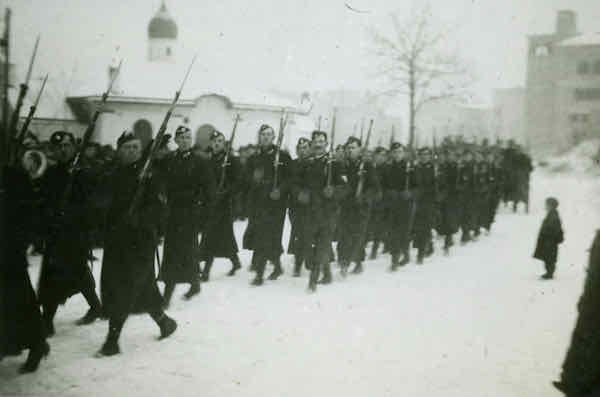



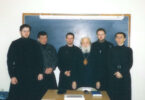
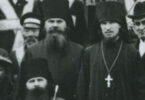
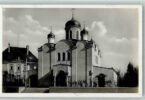
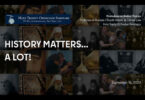
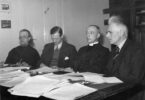

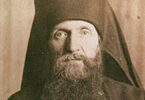
Thank you, ROCOR Studies for this enlightening series of articles about the relationship of the ROCOR with the Nazi authorities during WWII.
Given this historical legacy of collaboration with the Nazis and the desire of the ROCOR to advance its interests in the occupied territories through the Nazi occupied-land administrators, the current stance of many of our hierarchs and clergy to embrace the so-called “de-nazification” of Ukraine seems hypocritical. At the same time, ROCOR’s glad acceptance of the fascist rule of the President of the Russian Federation – in order to advance the Moscow Patriarchate’s lotus dreams of an earthly “Christian Empire” – makes perfect sense to me now.
From the article:
“In the early days of World War II, certain ROCOR bishops and priests wrote articles and proclamations welcoming the Wehrmacht’s campaign in the USSR.”
“After the German attack in the spring of 1942, in the expectation that Moscow would be captured by the summer, the Synod decided to make preparations for this scenario and made one last appeal to the German authorities with suggestions for how to organize church governance in Russia.” [I found this sentence particularly striking especially given how the Nazis were literally frozen in their tracks kilometers outside of Moscow through the intercessions of the Bogoroditsa (The Vladmir Icon Mother of God icon was flown around the city). and through intercessions the St. Matrona of Moscow. General Zhuikov’s counter-attack with his Siberian divisions was especially wonderful. Too bad that the ROCOR of 1942 could not appreciate these answered prayers!]
“In 1943, evidently trying to break out of its isolation and feeling alarmed about its future, the Synod of Bishops took the liberty to do what it had not done previously (or afterward) and sent several letters of congratulations to representatives of the occupying authorities, to which it received grateful replies. For instance, on February 16, 1943, the Synod heard letters of thanks for the Synod’s Christmas greetings from the adjutant to the commander-in-chief of the German Forces in Serbia, the Feldkommandant, and the German consul in Belgrade, and on May 17 of the same year, it heard letters from General Bader, Commander-in-Chief of the German forces in Serbia, and foreign affairs officer Benzler “thanking them for their greetings on the occasion of the birthday of Adolf Hitler, the Führer of the German people”. [“Happy Birthday, Adolph Hitler!” Love, ROCOR.” Pretty sickening.]